Prepare final accounts for sole traders and partnerships: Assignment
VerifiedAdded on 2021/01/01
|16
|4669
|274
AI Summary
Contribute Materials
Your contribution can guide someone’s learning journey. Share your
documents today.

Prepare final accounts for sole
traders and partnerships
traders and partnerships
Secure Best Marks with AI Grader
Need help grading? Try our AI Grader for instant feedback on your assignments.

Table of Contents
INTRODUCTION................................................................................................................................3
TASK 1.................................................................................................................................................3
1.1 Reasons for closing off accounts and producing a trial balance ..........................................3
1.2 The process, limitation of preparing a set of final accounts from a trial balance ................3
1.3 Methods of constructing accounts from incomplete records................................................4
1.4 Reasons for Imbalances resulting from incorrect double entries..........................................4
1.5 Reasons for incomplete records arising from insufficient data and inconsistencies within the
data provided ..............................................................................................................................4
TASK 2.................................................................................................................................................5
2.3 Sales and purchase leader control accounts .........................................................................6
2.4 Account balances using Mark Ups and margins .................................................................6
TASK 3.................................................................................................................................................6
3.1 Components of set of finals accounts for a sole trader ........................................................6
3.2 Statement of profit and loss .................................................................................................7
3.3 Statement of financial position ............................................................................................8
TASK 4.................................................................................................................................................9
4.1 Key components of partnership agreement...........................................................................9
4.2 Key components of partnership accounts ...........................................................................9
TASK 5...............................................................................................................................................10
5.1 statement of profit and loss appropriation account ............................................................10
5.2 Allocation of profit to partners after allowing interest on capital and drawing .................11
5.3 capital account and current for each partner......................................................................12
TASK 6 ..............................................................................................................................................13
6.1 and 6.2 statement of balance sheet.....................................................................................13
CONCLUSION..................................................................................................................................13
REFERENCES...................................................................................................................................14
INTRODUCTION................................................................................................................................3
TASK 1.................................................................................................................................................3
1.1 Reasons for closing off accounts and producing a trial balance ..........................................3
1.2 The process, limitation of preparing a set of final accounts from a trial balance ................3
1.3 Methods of constructing accounts from incomplete records................................................4
1.4 Reasons for Imbalances resulting from incorrect double entries..........................................4
1.5 Reasons for incomplete records arising from insufficient data and inconsistencies within the
data provided ..............................................................................................................................4
TASK 2.................................................................................................................................................5
2.3 Sales and purchase leader control accounts .........................................................................6
2.4 Account balances using Mark Ups and margins .................................................................6
TASK 3.................................................................................................................................................6
3.1 Components of set of finals accounts for a sole trader ........................................................6
3.2 Statement of profit and loss .................................................................................................7
3.3 Statement of financial position ............................................................................................8
TASK 4.................................................................................................................................................9
4.1 Key components of partnership agreement...........................................................................9
4.2 Key components of partnership accounts ...........................................................................9
TASK 5...............................................................................................................................................10
5.1 statement of profit and loss appropriation account ............................................................10
5.2 Allocation of profit to partners after allowing interest on capital and drawing .................11
5.3 capital account and current for each partner......................................................................12
TASK 6 ..............................................................................................................................................13
6.1 and 6.2 statement of balance sheet.....................................................................................13
CONCLUSION..................................................................................................................................13
REFERENCES...................................................................................................................................14
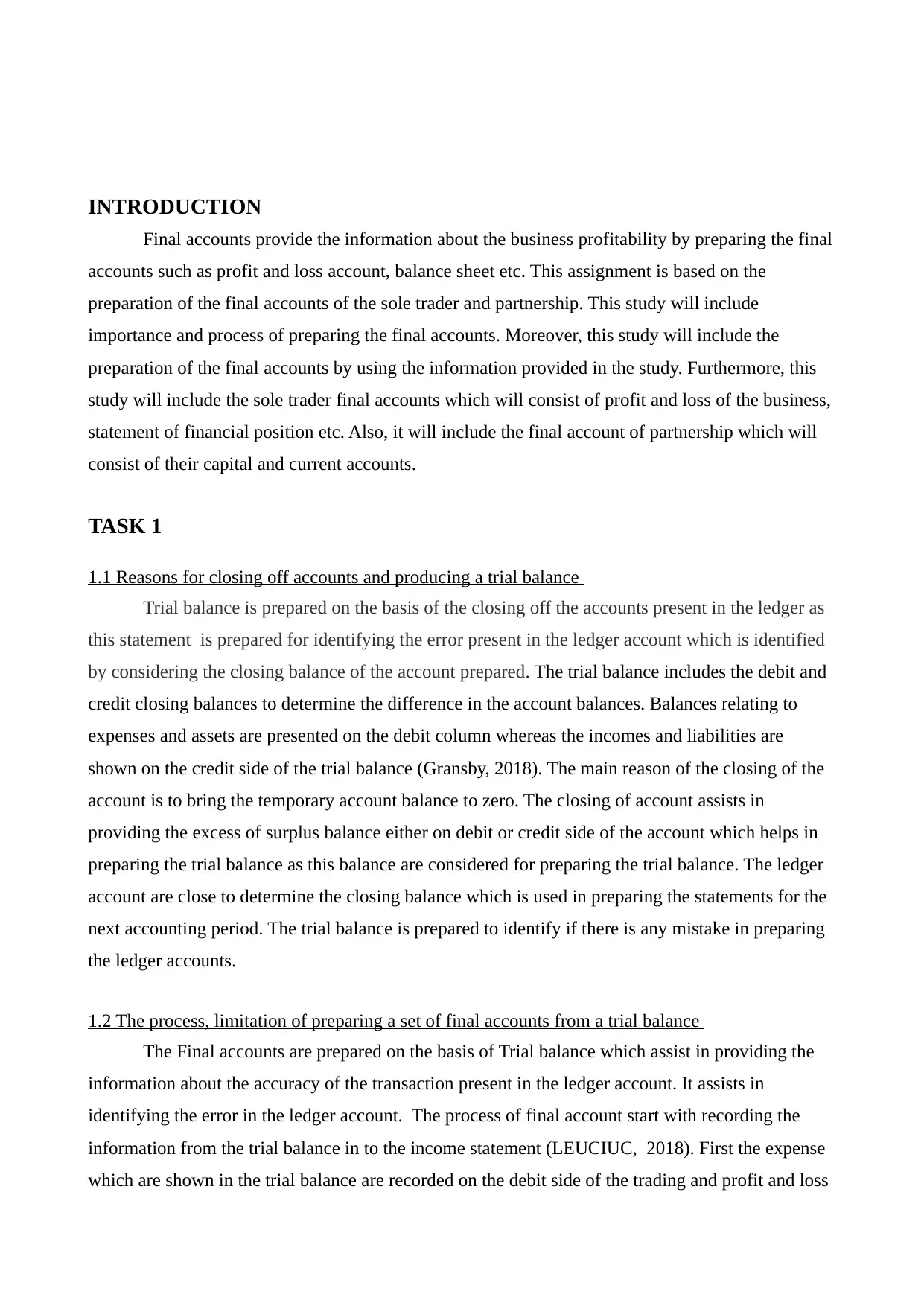
INTRODUCTION
Final accounts provide the information about the business profitability by preparing the final
accounts such as profit and loss account, balance sheet etc. This assignment is based on the
preparation of the final accounts of the sole trader and partnership. This study will include
importance and process of preparing the final accounts. Moreover, this study will include the
preparation of the final accounts by using the information provided in the study. Furthermore, this
study will include the sole trader final accounts which will consist of profit and loss of the business,
statement of financial position etc. Also, it will include the final account of partnership which will
consist of their capital and current accounts.
TASK 1
1.1 Reasons for closing off accounts and producing a trial balance
Trial balance is prepared on the basis of the closing off the accounts present in the ledger as
this statement is prepared for identifying the error present in the ledger account which is identified
by considering the closing balance of the account prepared. The trial balance includes the debit and
credit closing balances to determine the difference in the account balances. Balances relating to
expenses and assets are presented on the debit column whereas the incomes and liabilities are
shown on the credit side of the trial balance (Gransby, 2018). The main reason of the closing of the
account is to bring the temporary account balance to zero. The closing of account assists in
providing the excess of surplus balance either on debit or credit side of the account which helps in
preparing the trial balance as this balance are considered for preparing the trial balance. The ledger
account are close to determine the closing balance which is used in preparing the statements for the
next accounting period. The trial balance is prepared to identify if there is any mistake in preparing
the ledger accounts.
1.2 The process, limitation of preparing a set of final accounts from a trial balance
The Final accounts are prepared on the basis of Trial balance which assist in providing the
information about the accuracy of the transaction present in the ledger account. It assists in
identifying the error in the ledger account. The process of final account start with recording the
information from the trial balance in to the income statement (LEUCIUC, 2018). First the expense
which are shown in the trial balance are recorded on the debit side of the trading and profit and loss
Final accounts provide the information about the business profitability by preparing the final
accounts such as profit and loss account, balance sheet etc. This assignment is based on the
preparation of the final accounts of the sole trader and partnership. This study will include
importance and process of preparing the final accounts. Moreover, this study will include the
preparation of the final accounts by using the information provided in the study. Furthermore, this
study will include the sole trader final accounts which will consist of profit and loss of the business,
statement of financial position etc. Also, it will include the final account of partnership which will
consist of their capital and current accounts.
TASK 1
1.1 Reasons for closing off accounts and producing a trial balance
Trial balance is prepared on the basis of the closing off the accounts present in the ledger as
this statement is prepared for identifying the error present in the ledger account which is identified
by considering the closing balance of the account prepared. The trial balance includes the debit and
credit closing balances to determine the difference in the account balances. Balances relating to
expenses and assets are presented on the debit column whereas the incomes and liabilities are
shown on the credit side of the trial balance (Gransby, 2018). The main reason of the closing of the
account is to bring the temporary account balance to zero. The closing of account assists in
providing the excess of surplus balance either on debit or credit side of the account which helps in
preparing the trial balance as this balance are considered for preparing the trial balance. The ledger
account are close to determine the closing balance which is used in preparing the statements for the
next accounting period. The trial balance is prepared to identify if there is any mistake in preparing
the ledger accounts.
1.2 The process, limitation of preparing a set of final accounts from a trial balance
The Final accounts are prepared on the basis of Trial balance which assist in providing the
information about the accuracy of the transaction present in the ledger account. It assists in
identifying the error in the ledger account. The process of final account start with recording the
information from the trial balance in to the income statement (LEUCIUC, 2018). First the expense
which are shown in the trial balance are recorded on the debit side of the trading and profit and loss

statement. Then the incomes in the trial balance are recorded on the credit side of the profit and loss
account that assist in identifying the net profit of the period. Moreover, the other debit balance of
the trial balance are shown on the assets side of balance sheet and the credit balances are shown on
the liabilities side on the balance sheet that assist in identify the financial position of the business on
the specific date. By preparing the final accounts from the trial balance can affect the final accounts
as if the ledgers are prepared in the wrong manner then the trial balance will show the inaccurate
balances which will reduce the accuracy of the final accounts as it will not show the profit and
financial position of the firm (ACCOUNTS FOR INCOMPLETE RECORDS, 2017). If there is error
of omission in the trial balance will affect the final accounts and will do not reflect the true and fair
position of the financial statement.
1.3 Methods of constructing accounts from incomplete records
Incomplete records of the company are those for which the company does not have the
accurate information. Account for these records are prepared using the accounting equations.
Moreover, For preparing the accounts one aspect of transaction is recorded. The profit and loss
statement is prepared by preparing the statement of affairs at the beginning and at the end of
period. Moreover, the statement of assets and liabilities is prepared at the beginning and end to
ascertain the change in capital. The incomplete records is the situation in which the organisation
does not use double entry method of bookkeeping. The single -entry method is used in constructing
accounts from the incomplete records. In the incomplete record only the personal accounts are
considered. Single- entry system in which either one- sided or no entry is made. In this method of
preparing accounts record of cash and personal accounts of debtors and creditors are maintained
properly (Nuthall and Old, 2017). In this system information relating to assets, liabilities, incomes
and expenses is partially recorded. This method is unsystematic of recording transactions and to
determine the net profit information collected from the original vouchers such as sales invoice etc.
Ass per this method the profit is estimated as the information is incomplete due to which the profit
or loss recorded is estimated.
1.4 Reasons for Imbalances resulting from incorrect double entries.
The incorrect entries in the journal accounts result into unequal balances due to which the
final accounts prepared are inaccurate and does not contain the true information relating to the
transactions. The main reasons of the imbalances includes the misappropriation of the amount in the
double entries will give the inaccurate balances which will affect the final accounts and thus the
profit and loss statement will not show the correct not profit (Rant and et.al., 2017). Moreover, the
incorrect transaction in the journal will cause the finals accounts to be inappropriate. Furthermore,
account that assist in identifying the net profit of the period. Moreover, the other debit balance of
the trial balance are shown on the assets side of balance sheet and the credit balances are shown on
the liabilities side on the balance sheet that assist in identify the financial position of the business on
the specific date. By preparing the final accounts from the trial balance can affect the final accounts
as if the ledgers are prepared in the wrong manner then the trial balance will show the inaccurate
balances which will reduce the accuracy of the final accounts as it will not show the profit and
financial position of the firm (ACCOUNTS FOR INCOMPLETE RECORDS, 2017). If there is error
of omission in the trial balance will affect the final accounts and will do not reflect the true and fair
position of the financial statement.
1.3 Methods of constructing accounts from incomplete records
Incomplete records of the company are those for which the company does not have the
accurate information. Account for these records are prepared using the accounting equations.
Moreover, For preparing the accounts one aspect of transaction is recorded. The profit and loss
statement is prepared by preparing the statement of affairs at the beginning and at the end of
period. Moreover, the statement of assets and liabilities is prepared at the beginning and end to
ascertain the change in capital. The incomplete records is the situation in which the organisation
does not use double entry method of bookkeeping. The single -entry method is used in constructing
accounts from the incomplete records. In the incomplete record only the personal accounts are
considered. Single- entry system in which either one- sided or no entry is made. In this method of
preparing accounts record of cash and personal accounts of debtors and creditors are maintained
properly (Nuthall and Old, 2017). In this system information relating to assets, liabilities, incomes
and expenses is partially recorded. This method is unsystematic of recording transactions and to
determine the net profit information collected from the original vouchers such as sales invoice etc.
Ass per this method the profit is estimated as the information is incomplete due to which the profit
or loss recorded is estimated.
1.4 Reasons for Imbalances resulting from incorrect double entries.
The incorrect entries in the journal accounts result into unequal balances due to which the
final accounts prepared are inaccurate and does not contain the true information relating to the
transactions. The main reasons of the imbalances includes the misappropriation of the amount in the
double entries will give the inaccurate balances which will affect the final accounts and thus the
profit and loss statement will not show the correct not profit (Rant and et.al., 2017). Moreover, the
incorrect transaction in the journal will cause the finals accounts to be inappropriate. Furthermore,
Paraphrase This Document
Need a fresh take? Get an instant paraphrase of this document with our AI Paraphraser
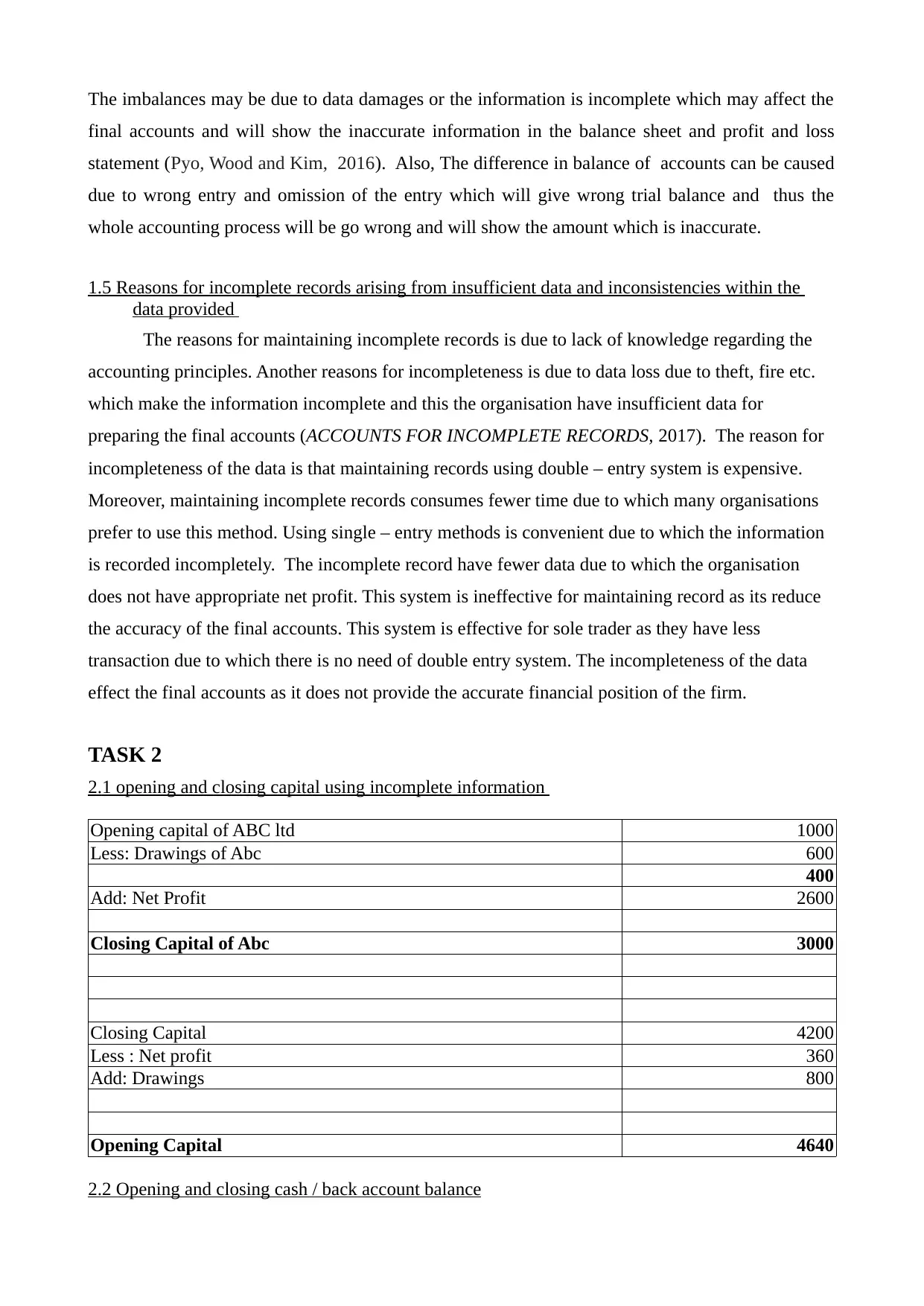
The imbalances may be due to data damages or the information is incomplete which may affect the
final accounts and will show the inaccurate information in the balance sheet and profit and loss
statement (Pyo, Wood and Kim, 2016). Also, The difference in balance of accounts can be caused
due to wrong entry and omission of the entry which will give wrong trial balance and thus the
whole accounting process will be go wrong and will show the amount which is inaccurate.
1.5 Reasons for incomplete records arising from insufficient data and inconsistencies within the
data provided
The reasons for maintaining incomplete records is due to lack of knowledge regarding the
accounting principles. Another reasons for incompleteness is due to data loss due to theft, fire etc.
which make the information incomplete and this the organisation have insufficient data for
preparing the final accounts (ACCOUNTS FOR INCOMPLETE RECORDS, 2017). The reason for
incompleteness of the data is that maintaining records using double – entry system is expensive.
Moreover, maintaining incomplete records consumes fewer time due to which many organisations
prefer to use this method. Using single – entry methods is convenient due to which the information
is recorded incompletely. The incomplete record have fewer data due to which the organisation
does not have appropriate net profit. This system is ineffective for maintaining record as its reduce
the accuracy of the final accounts. This system is effective for sole trader as they have less
transaction due to which there is no need of double entry system. The incompleteness of the data
effect the final accounts as it does not provide the accurate financial position of the firm.
TASK 2
2.1 opening and closing capital using incomplete information
Opening capital of ABC ltd 1000
Less: Drawings of Abc 600
400
Add: Net Profit 2600
Closing Capital of Abc 3000
Closing Capital 4200
Less : Net profit 360
Add: Drawings 800
Opening Capital 4640
2.2 Opening and closing cash / back account balance
final accounts and will show the inaccurate information in the balance sheet and profit and loss
statement (Pyo, Wood and Kim, 2016). Also, The difference in balance of accounts can be caused
due to wrong entry and omission of the entry which will give wrong trial balance and thus the
whole accounting process will be go wrong and will show the amount which is inaccurate.
1.5 Reasons for incomplete records arising from insufficient data and inconsistencies within the
data provided
The reasons for maintaining incomplete records is due to lack of knowledge regarding the
accounting principles. Another reasons for incompleteness is due to data loss due to theft, fire etc.
which make the information incomplete and this the organisation have insufficient data for
preparing the final accounts (ACCOUNTS FOR INCOMPLETE RECORDS, 2017). The reason for
incompleteness of the data is that maintaining records using double – entry system is expensive.
Moreover, maintaining incomplete records consumes fewer time due to which many organisations
prefer to use this method. Using single – entry methods is convenient due to which the information
is recorded incompletely. The incomplete record have fewer data due to which the organisation
does not have appropriate net profit. This system is ineffective for maintaining record as its reduce
the accuracy of the final accounts. This system is effective for sole trader as they have less
transaction due to which there is no need of double entry system. The incompleteness of the data
effect the final accounts as it does not provide the accurate financial position of the firm.
TASK 2
2.1 opening and closing capital using incomplete information
Opening capital of ABC ltd 1000
Less: Drawings of Abc 600
400
Add: Net Profit 2600
Closing Capital of Abc 3000
Closing Capital 4200
Less : Net profit 360
Add: Drawings 800
Opening Capital 4640
2.2 Opening and closing cash / back account balance
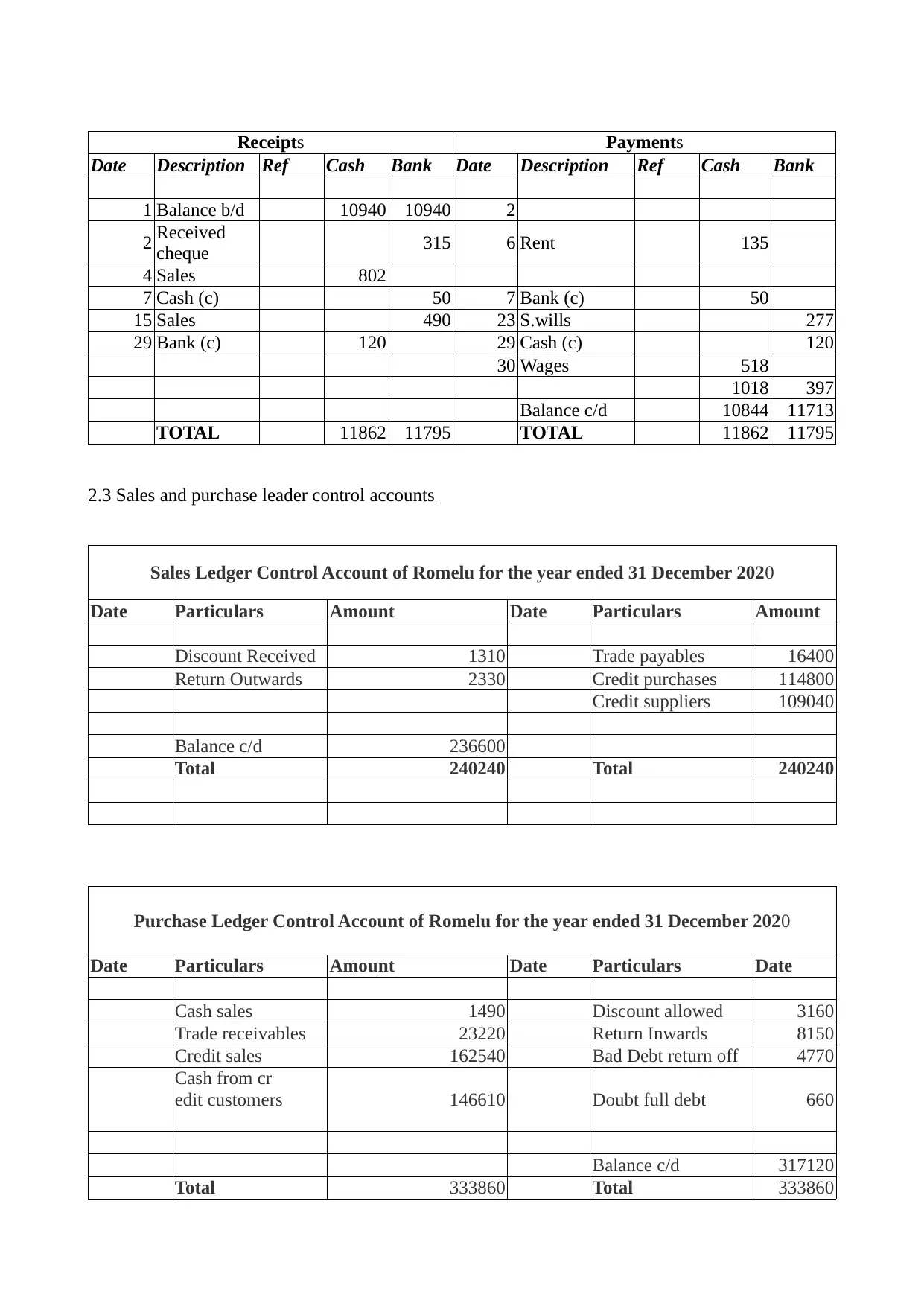
Receipts Payments
Date Description Ref Cash Bank Date Description Ref Cash Bank
1 Balance b/d 10940 10940 2
2 Received
cheque 315 6 Rent 135
4 Sales 802
7 Cash (c) 50 7 Bank (c) 50
15 Sales 490 23 S.wills 277
29 Bank (c) 120 29 Cash (c) 120
30 Wages 518
1018 397
Balance c/d 10844 11713
TOTAL 11862 11795 TOTAL 11862 11795
2.3 Sales and purchase leader control accounts
Sales Ledger Control Account of Romelu for the year ended 31 December 2020
Date Particulars Amount Date Particulars Amount
Discount Received 1310 Trade payables 16400
Return Outwards 2330 Credit purchases 114800
Credit suppliers 109040
Balance c/d 236600
Total 240240 Total 240240
Purchase Ledger Control Account of Romelu for the year ended 31 December 2020
Date Particulars Amount Date Particulars Date
Cash sales 1490 Discount allowed 3160
Trade receivables 23220 Return Inwards 8150
Credit sales 162540 Bad Debt return off 4770
Cash from cr
edit customers 146610 Doubt full debt 660
Balance c/d 317120
Total 333860 Total 333860
Date Description Ref Cash Bank Date Description Ref Cash Bank
1 Balance b/d 10940 10940 2
2 Received
cheque 315 6 Rent 135
4 Sales 802
7 Cash (c) 50 7 Bank (c) 50
15 Sales 490 23 S.wills 277
29 Bank (c) 120 29 Cash (c) 120
30 Wages 518
1018 397
Balance c/d 10844 11713
TOTAL 11862 11795 TOTAL 11862 11795
2.3 Sales and purchase leader control accounts
Sales Ledger Control Account of Romelu for the year ended 31 December 2020
Date Particulars Amount Date Particulars Amount
Discount Received 1310 Trade payables 16400
Return Outwards 2330 Credit purchases 114800
Credit suppliers 109040
Balance c/d 236600
Total 240240 Total 240240
Purchase Ledger Control Account of Romelu for the year ended 31 December 2020
Date Particulars Amount Date Particulars Date
Cash sales 1490 Discount allowed 3160
Trade receivables 23220 Return Inwards 8150
Credit sales 162540 Bad Debt return off 4770
Cash from cr
edit customers 146610 Doubt full debt 660
Balance c/d 317120
Total 333860 Total 333860
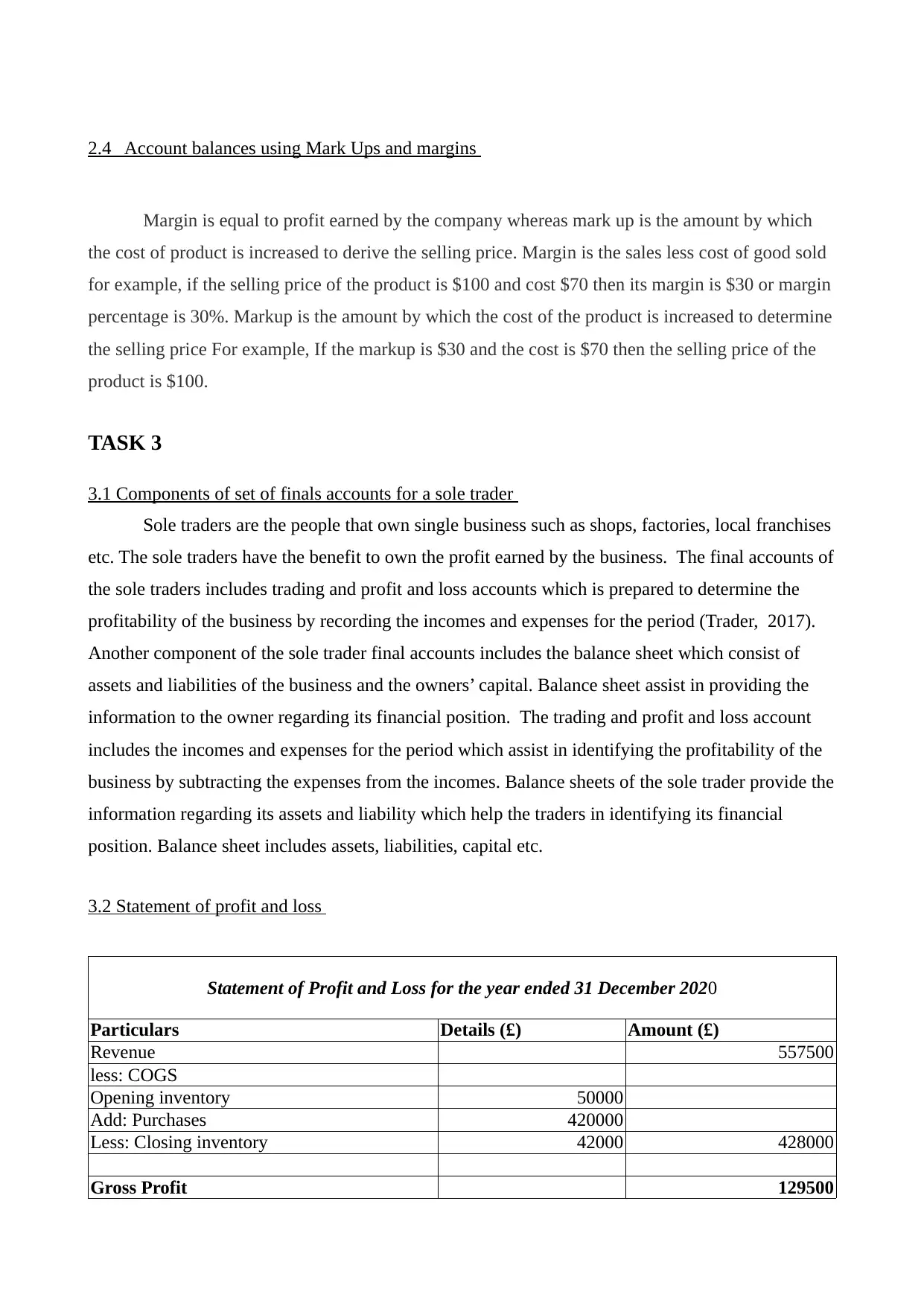
2.4 Account balances using Mark Ups and margins
Margin is equal to profit earned by the company whereas mark up is the amount by which
the cost of product is increased to derive the selling price. Margin is the sales less cost of good sold
for example, if the selling price of the product is $100 and cost $70 then its margin is $30 or margin
percentage is 30%. Markup is the amount by which the cost of the product is increased to determine
the selling price For example, If the markup is $30 and the cost is $70 then the selling price of the
product is $100.
TASK 3
3.1 Components of set of finals accounts for a sole trader
Sole traders are the people that own single business such as shops, factories, local franchises
etc. The sole traders have the benefit to own the profit earned by the business. The final accounts of
the sole traders includes trading and profit and loss accounts which is prepared to determine the
profitability of the business by recording the incomes and expenses for the period (Trader, 2017).
Another component of the sole trader final accounts includes the balance sheet which consist of
assets and liabilities of the business and the owners’ capital. Balance sheet assist in providing the
information to the owner regarding its financial position. The trading and profit and loss account
includes the incomes and expenses for the period which assist in identifying the profitability of the
business by subtracting the expenses from the incomes. Balance sheets of the sole trader provide the
information regarding its assets and liability which help the traders in identifying its financial
position. Balance sheet includes assets, liabilities, capital etc.
3.2 Statement of profit and loss
Statement of Profit and Loss for the year ended 31 December 2020
Particulars Details (£) Amount (£)
Revenue 557500
less: COGS
Opening inventory 50000
Add: Purchases 420000
Less: Closing inventory 42000 428000
Gross Profit 129500
Margin is equal to profit earned by the company whereas mark up is the amount by which
the cost of product is increased to derive the selling price. Margin is the sales less cost of good sold
for example, if the selling price of the product is $100 and cost $70 then its margin is $30 or margin
percentage is 30%. Markup is the amount by which the cost of the product is increased to determine
the selling price For example, If the markup is $30 and the cost is $70 then the selling price of the
product is $100.
TASK 3
3.1 Components of set of finals accounts for a sole trader
Sole traders are the people that own single business such as shops, factories, local franchises
etc. The sole traders have the benefit to own the profit earned by the business. The final accounts of
the sole traders includes trading and profit and loss accounts which is prepared to determine the
profitability of the business by recording the incomes and expenses for the period (Trader, 2017).
Another component of the sole trader final accounts includes the balance sheet which consist of
assets and liabilities of the business and the owners’ capital. Balance sheet assist in providing the
information to the owner regarding its financial position. The trading and profit and loss account
includes the incomes and expenses for the period which assist in identifying the profitability of the
business by subtracting the expenses from the incomes. Balance sheets of the sole trader provide the
information regarding its assets and liability which help the traders in identifying its financial
position. Balance sheet includes assets, liabilities, capital etc.
3.2 Statement of profit and loss
Statement of Profit and Loss for the year ended 31 December 2020
Particulars Details (£) Amount (£)
Revenue 557500
less: COGS
Opening inventory 50000
Add: Purchases 420000
Less: Closing inventory 42000 428000
Gross Profit 129500
Secure Best Marks with AI Grader
Need help grading? Try our AI Grader for instant feedback on your assignments.
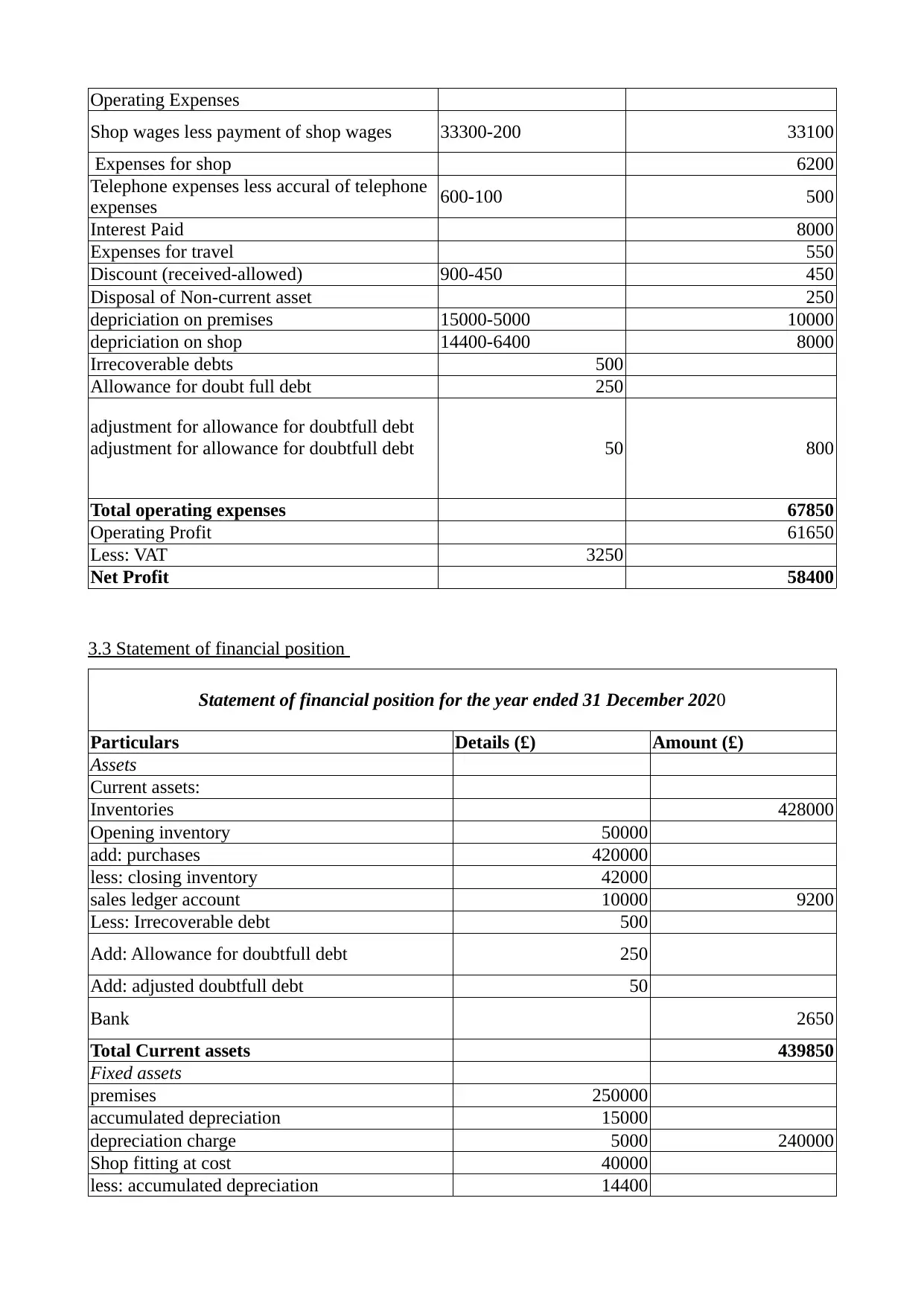
Operating Expenses
Shop wages less payment of shop wages 33300-200 33100
Expenses for shop 6200
Telephone expenses less accural of telephone
expenses 600-100 500
Interest Paid 8000
Expenses for travel 550
Discount (received-allowed) 900-450 450
Disposal of Non-current asset 250
depriciation on premises 15000-5000 10000
depriciation on shop 14400-6400 8000
Irrecoverable debts 500
Allowance for doubt full debt 250
adjustment for allowance for doubtfull debt
adjustment for allowance for doubtfull debt 50 800
Total operating expenses 67850
Operating Profit 61650
Less: VAT 3250
Net Profit 58400
3.3 Statement of financial position
Statement of financial position for the year ended 31 December 2020
Particulars Details (£) Amount (£)
Assets
Current assets:
Inventories 428000
Opening inventory 50000
add: purchases 420000
less: closing inventory 42000
sales ledger account 10000 9200
Less: Irrecoverable debt 500
Add: Allowance for doubtfull debt 250
Add: adjusted doubtfull debt 50
Bank 2650
Total Current assets 439850
Fixed assets
premises 250000
accumulated depreciation 15000
depreciation charge 5000 240000
Shop fitting at cost 40000
less: accumulated depreciation 14400
Shop wages less payment of shop wages 33300-200 33100
Expenses for shop 6200
Telephone expenses less accural of telephone
expenses 600-100 500
Interest Paid 8000
Expenses for travel 550
Discount (received-allowed) 900-450 450
Disposal of Non-current asset 250
depriciation on premises 15000-5000 10000
depriciation on shop 14400-6400 8000
Irrecoverable debts 500
Allowance for doubt full debt 250
adjustment for allowance for doubtfull debt
adjustment for allowance for doubtfull debt 50 800
Total operating expenses 67850
Operating Profit 61650
Less: VAT 3250
Net Profit 58400
3.3 Statement of financial position
Statement of financial position for the year ended 31 December 2020
Particulars Details (£) Amount (£)
Assets
Current assets:
Inventories 428000
Opening inventory 50000
add: purchases 420000
less: closing inventory 42000
sales ledger account 10000 9200
Less: Irrecoverable debt 500
Add: Allowance for doubtfull debt 250
Add: adjusted doubtfull debt 50
Bank 2650
Total Current assets 439850
Fixed assets
premises 250000
accumulated depreciation 15000
depreciation charge 5000 240000
Shop fitting at cost 40000
less: accumulated depreciation 14400
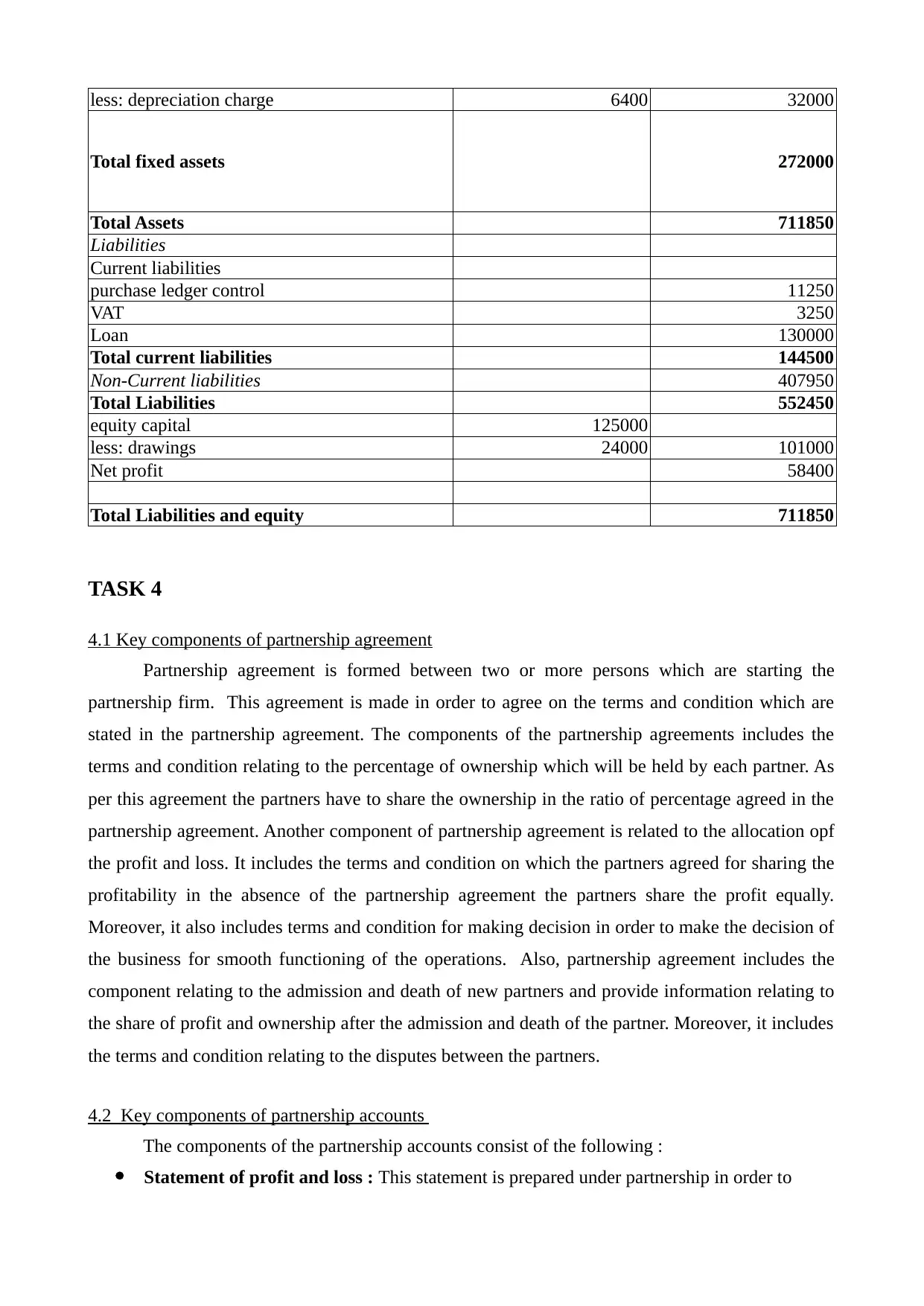
less: depreciation charge 6400 32000
Total fixed assets 272000
Total Assets 711850
Liabilities
Current liabilities
purchase ledger control 11250
VAT 3250
Loan 130000
Total current liabilities 144500
Non-Current liabilities 407950
Total Liabilities 552450
equity capital 125000
less: drawings 24000 101000
Net profit 58400
Total Liabilities and equity 711850
TASK 4
4.1 Key components of partnership agreement
Partnership agreement is formed between two or more persons which are starting the
partnership firm. This agreement is made in order to agree on the terms and condition which are
stated in the partnership agreement. The components of the partnership agreements includes the
terms and condition relating to the percentage of ownership which will be held by each partner. As
per this agreement the partners have to share the ownership in the ratio of percentage agreed in the
partnership agreement. Another component of partnership agreement is related to the allocation opf
the profit and loss. It includes the terms and condition on which the partners agreed for sharing the
profitability in the absence of the partnership agreement the partners share the profit equally.
Moreover, it also includes terms and condition for making decision in order to make the decision of
the business for smooth functioning of the operations. Also, partnership agreement includes the
component relating to the admission and death of new partners and provide information relating to
the share of profit and ownership after the admission and death of the partner. Moreover, it includes
the terms and condition relating to the disputes between the partners.
4.2 Key components of partnership accounts
The components of the partnership accounts consist of the following :
Statement of profit and loss : This statement is prepared under partnership in order to
Total fixed assets 272000
Total Assets 711850
Liabilities
Current liabilities
purchase ledger control 11250
VAT 3250
Loan 130000
Total current liabilities 144500
Non-Current liabilities 407950
Total Liabilities 552450
equity capital 125000
less: drawings 24000 101000
Net profit 58400
Total Liabilities and equity 711850
TASK 4
4.1 Key components of partnership agreement
Partnership agreement is formed between two or more persons which are starting the
partnership firm. This agreement is made in order to agree on the terms and condition which are
stated in the partnership agreement. The components of the partnership agreements includes the
terms and condition relating to the percentage of ownership which will be held by each partner. As
per this agreement the partners have to share the ownership in the ratio of percentage agreed in the
partnership agreement. Another component of partnership agreement is related to the allocation opf
the profit and loss. It includes the terms and condition on which the partners agreed for sharing the
profitability in the absence of the partnership agreement the partners share the profit equally.
Moreover, it also includes terms and condition for making decision in order to make the decision of
the business for smooth functioning of the operations. Also, partnership agreement includes the
component relating to the admission and death of new partners and provide information relating to
the share of profit and ownership after the admission and death of the partner. Moreover, it includes
the terms and condition relating to the disputes between the partners.
4.2 Key components of partnership accounts
The components of the partnership accounts consist of the following :
Statement of profit and loss : This statement is prepared under partnership in order to
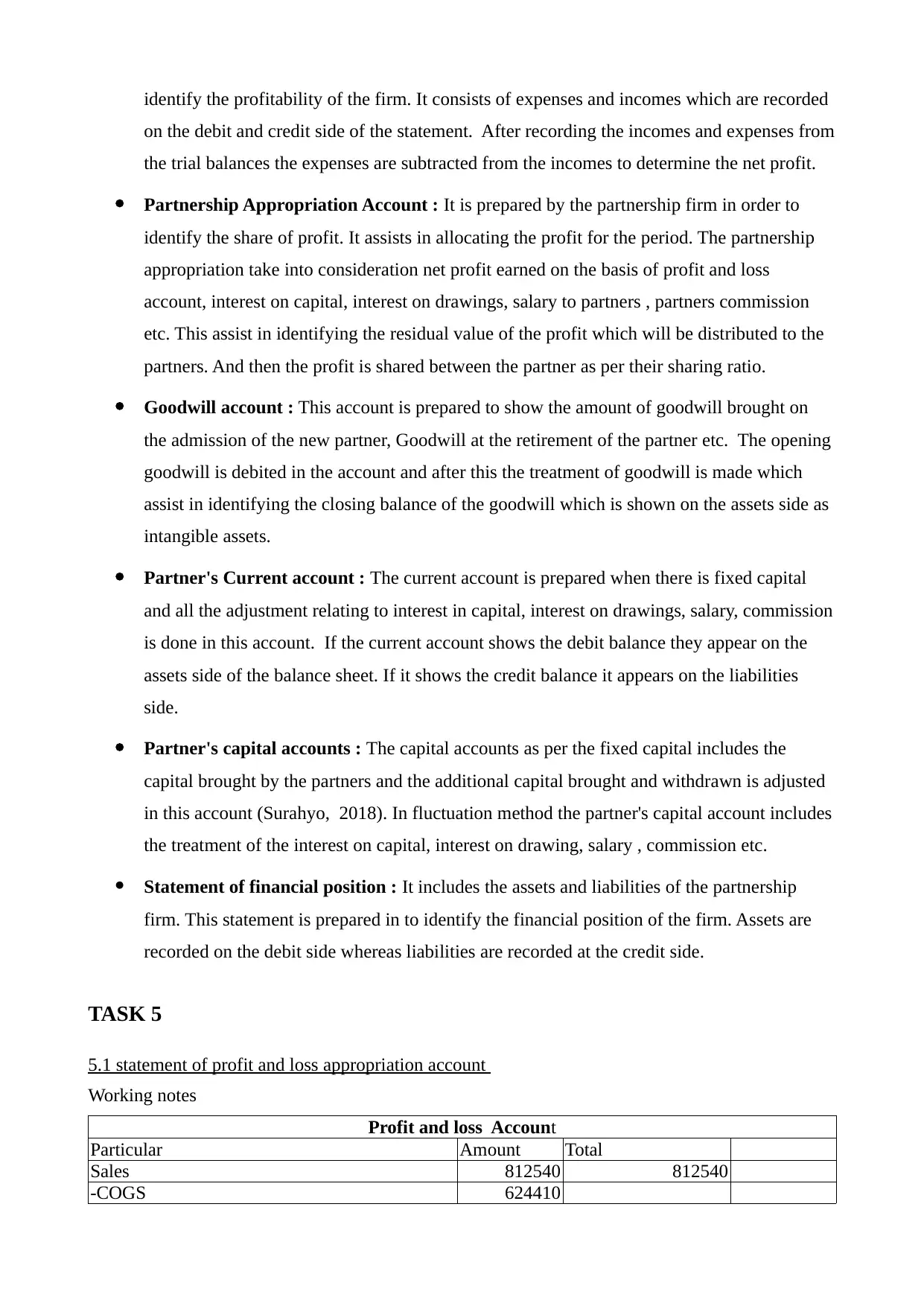
identify the profitability of the firm. It consists of expenses and incomes which are recorded
on the debit and credit side of the statement. After recording the incomes and expenses from
the trial balances the expenses are subtracted from the incomes to determine the net profit.
Partnership Appropriation Account : It is prepared by the partnership firm in order to
identify the share of profit. It assists in allocating the profit for the period. The partnership
appropriation take into consideration net profit earned on the basis of profit and loss
account, interest on capital, interest on drawings, salary to partners , partners commission
etc. This assist in identifying the residual value of the profit which will be distributed to the
partners. And then the profit is shared between the partner as per their sharing ratio.
Goodwill account : This account is prepared to show the amount of goodwill brought on
the admission of the new partner, Goodwill at the retirement of the partner etc. The opening
goodwill is debited in the account and after this the treatment of goodwill is made which
assist in identifying the closing balance of the goodwill which is shown on the assets side as
intangible assets.
Partner's Current account : The current account is prepared when there is fixed capital
and all the adjustment relating to interest in capital, interest on drawings, salary, commission
is done in this account. If the current account shows the debit balance they appear on the
assets side of the balance sheet. If it shows the credit balance it appears on the liabilities
side.
Partner's capital accounts : The capital accounts as per the fixed capital includes the
capital brought by the partners and the additional capital brought and withdrawn is adjusted
in this account (Surahyo, 2018). In fluctuation method the partner's capital account includes
the treatment of the interest on capital, interest on drawing, salary , commission etc.
Statement of financial position : It includes the assets and liabilities of the partnership
firm. This statement is prepared in to identify the financial position of the firm. Assets are
recorded on the debit side whereas liabilities are recorded at the credit side.
TASK 5
5.1 statement of profit and loss appropriation account
Working notes
Profit and loss Account
Particular Amount Total
Sales 812540 812540
-COGS 624410
on the debit and credit side of the statement. After recording the incomes and expenses from
the trial balances the expenses are subtracted from the incomes to determine the net profit.
Partnership Appropriation Account : It is prepared by the partnership firm in order to
identify the share of profit. It assists in allocating the profit for the period. The partnership
appropriation take into consideration net profit earned on the basis of profit and loss
account, interest on capital, interest on drawings, salary to partners , partners commission
etc. This assist in identifying the residual value of the profit which will be distributed to the
partners. And then the profit is shared between the partner as per their sharing ratio.
Goodwill account : This account is prepared to show the amount of goodwill brought on
the admission of the new partner, Goodwill at the retirement of the partner etc. The opening
goodwill is debited in the account and after this the treatment of goodwill is made which
assist in identifying the closing balance of the goodwill which is shown on the assets side as
intangible assets.
Partner's Current account : The current account is prepared when there is fixed capital
and all the adjustment relating to interest in capital, interest on drawings, salary, commission
is done in this account. If the current account shows the debit balance they appear on the
assets side of the balance sheet. If it shows the credit balance it appears on the liabilities
side.
Partner's capital accounts : The capital accounts as per the fixed capital includes the
capital brought by the partners and the additional capital brought and withdrawn is adjusted
in this account (Surahyo, 2018). In fluctuation method the partner's capital account includes
the treatment of the interest on capital, interest on drawing, salary , commission etc.
Statement of financial position : It includes the assets and liabilities of the partnership
firm. This statement is prepared in to identify the financial position of the firm. Assets are
recorded on the debit side whereas liabilities are recorded at the credit side.
TASK 5
5.1 statement of profit and loss appropriation account
Working notes
Profit and loss Account
Particular Amount Total
Sales 812540 812540
-COGS 624410
Paraphrase This Document
Need a fresh take? Get an instant paraphrase of this document with our AI Paraphraser
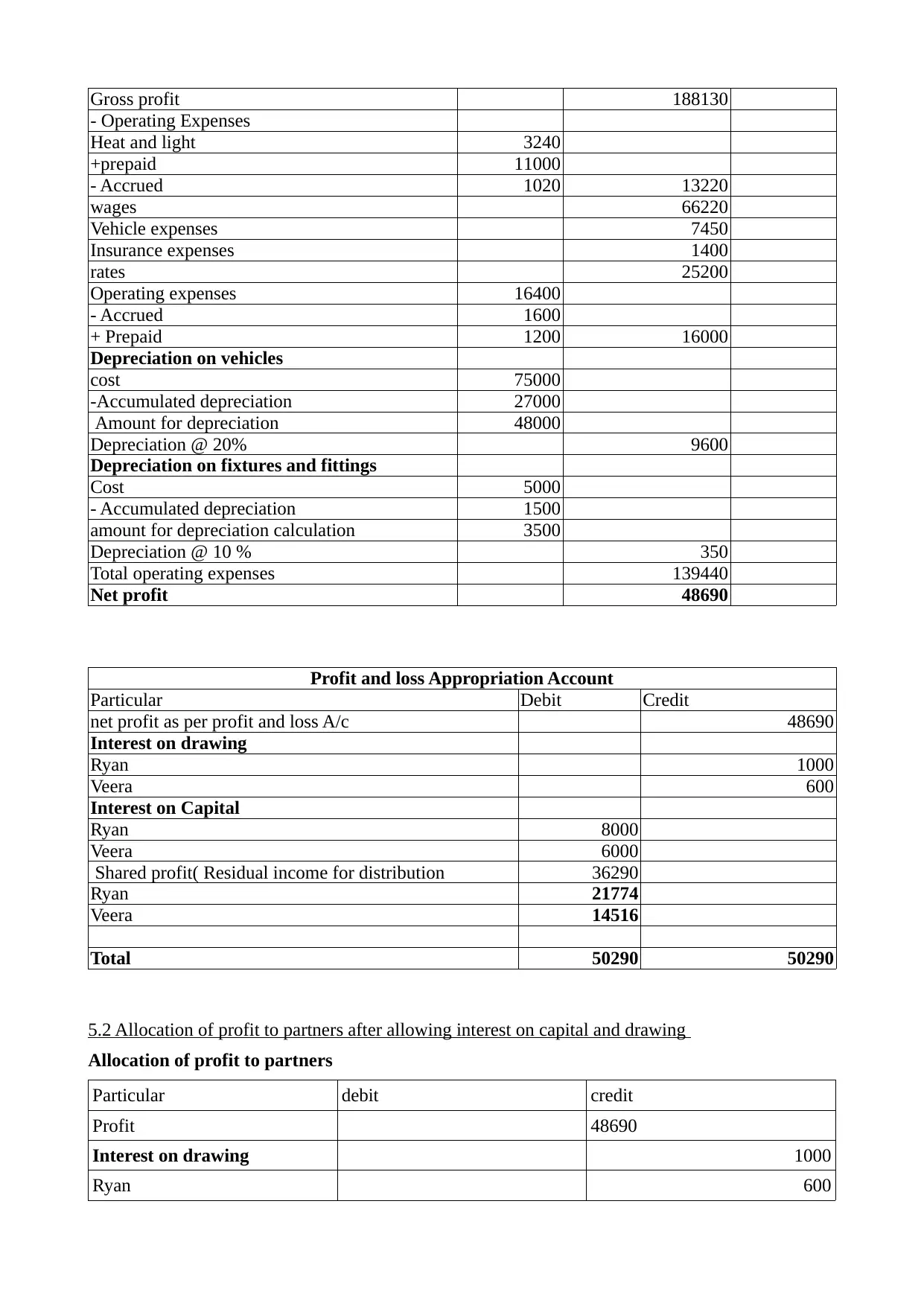
Gross profit 188130
- Operating Expenses
Heat and light 3240
+prepaid 11000
- Accrued 1020 13220
wages 66220
Vehicle expenses 7450
Insurance expenses 1400
rates 25200
Operating expenses 16400
- Accrued 1600
+ Prepaid 1200 16000
Depreciation on vehicles
cost 75000
-Accumulated depreciation 27000
Amount for depreciation 48000
Depreciation @ 20% 9600
Depreciation on fixtures and fittings
Cost 5000
- Accumulated depreciation 1500
amount for depreciation calculation 3500
Depreciation @ 10 % 350
Total operating expenses 139440
Net profit 48690
Profit and loss Appropriation Account
Particular Debit Credit
net profit as per profit and loss A/c 48690
Interest on drawing
Ryan 1000
Veera 600
Interest on Capital
Ryan 8000
Veera 6000
Shared profit( Residual income for distribution 36290
Ryan 21774
Veera 14516
Total 50290 50290
5.2 Allocation of profit to partners after allowing interest on capital and drawing
Allocation of profit to partners
Particular debit credit
Profit 48690
Interest on drawing 1000
Ryan 600
- Operating Expenses
Heat and light 3240
+prepaid 11000
- Accrued 1020 13220
wages 66220
Vehicle expenses 7450
Insurance expenses 1400
rates 25200
Operating expenses 16400
- Accrued 1600
+ Prepaid 1200 16000
Depreciation on vehicles
cost 75000
-Accumulated depreciation 27000
Amount for depreciation 48000
Depreciation @ 20% 9600
Depreciation on fixtures and fittings
Cost 5000
- Accumulated depreciation 1500
amount for depreciation calculation 3500
Depreciation @ 10 % 350
Total operating expenses 139440
Net profit 48690
Profit and loss Appropriation Account
Particular Debit Credit
net profit as per profit and loss A/c 48690
Interest on drawing
Ryan 1000
Veera 600
Interest on Capital
Ryan 8000
Veera 6000
Shared profit( Residual income for distribution 36290
Ryan 21774
Veera 14516
Total 50290 50290
5.2 Allocation of profit to partners after allowing interest on capital and drawing
Allocation of profit to partners
Particular debit credit
Profit 48690
Interest on drawing 1000
Ryan 600

Veera
Interest on Capital 8000
Ryan 6000
Veera 36290
Shared profit( Residual income
for distribution
21774
Ryan 14516
Veera
Capital Account of Ryan
Date Particular Amount Date Particular Amount
By balance b/d 200000
To balance c/d 150000
Total 200000 200000
Current Account of Ryan
Date Particular Amount Date Particular Amount
To balance b/d 1250
By interest on
capital 8000
To drawings 32000
By profit share of
Ryan 21774
To interest on
Drawings 1000
By balance c/d 4476
Capital Account of Veera
Date Particular Amount Date Particular Amount
By balance b/d 150000
To balance c/d 150000
Total 150000 Total 150000
Current Account of Veera
Date Particular Amount Date Particular Amount
To drawings 24000 By balance b/d 1600
To interest on
drawings 600
By interest on
capital 6000
By profit share of
Veera 14516
By balance c/d 2484
Total 24600 Total 24600
Interest on Capital 8000
Ryan 6000
Veera 36290
Shared profit( Residual income
for distribution
21774
Ryan 14516
Veera
Capital Account of Ryan
Date Particular Amount Date Particular Amount
By balance b/d 200000
To balance c/d 150000
Total 200000 200000
Current Account of Ryan
Date Particular Amount Date Particular Amount
To balance b/d 1250
By interest on
capital 8000
To drawings 32000
By profit share of
Ryan 21774
To interest on
Drawings 1000
By balance c/d 4476
Capital Account of Veera
Date Particular Amount Date Particular Amount
By balance b/d 150000
To balance c/d 150000
Total 150000 Total 150000
Current Account of Veera
Date Particular Amount Date Particular Amount
To drawings 24000 By balance b/d 1600
To interest on
drawings 600
By interest on
capital 6000
By profit share of
Veera 14516
By balance c/d 2484
Total 24600 Total 24600
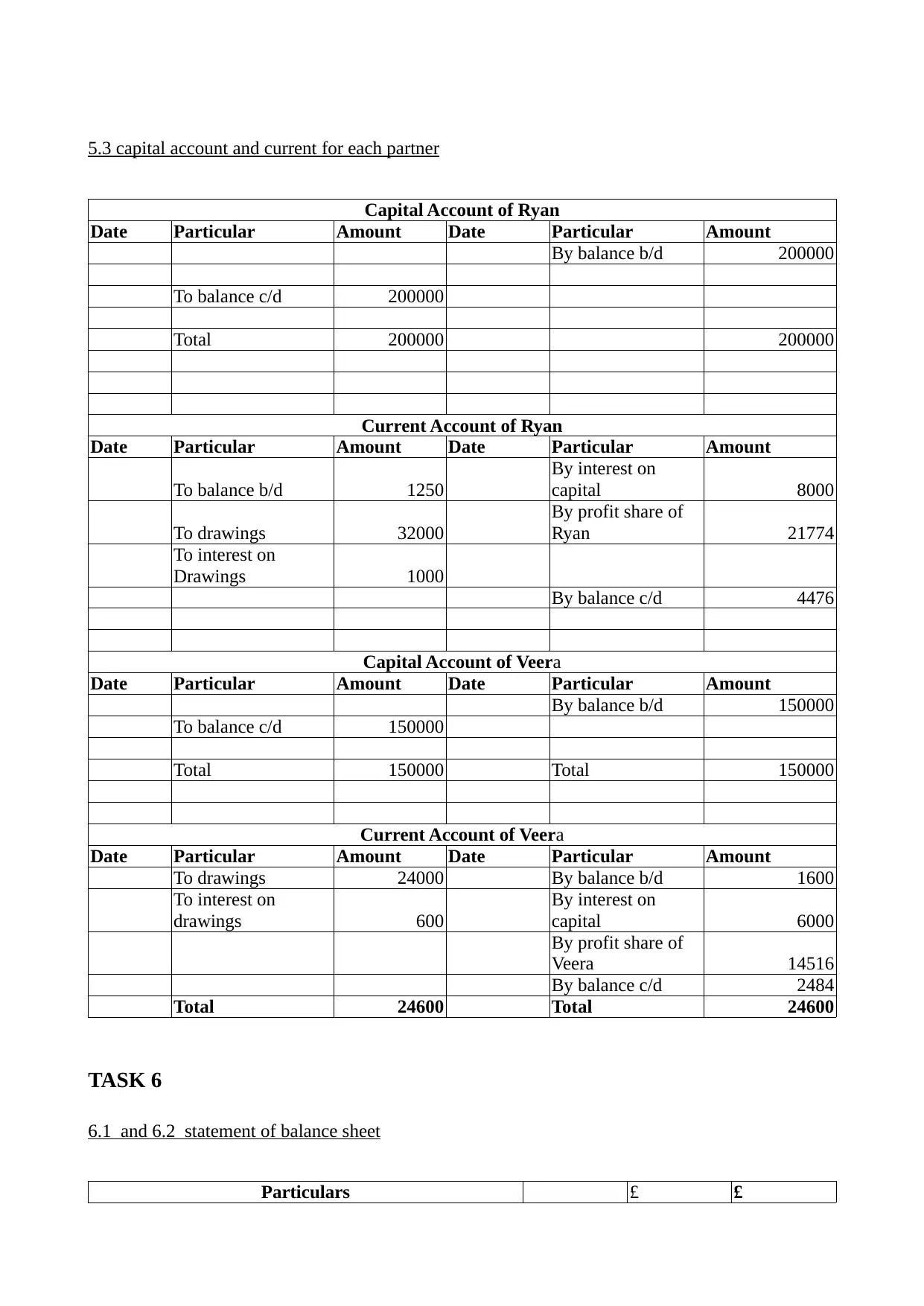
5.3 capital account and current for each partner
Capital Account of Ryan
Date Particular Amount Date Particular Amount
By balance b/d 200000
To balance c/d 200000
Total 200000 200000
Current Account of Ryan
Date Particular Amount Date Particular Amount
To balance b/d 1250
By interest on
capital 8000
To drawings 32000
By profit share of
Ryan 21774
To interest on
Drawings 1000
By balance c/d 4476
Capital Account of Veera
Date Particular Amount Date Particular Amount
By balance b/d 150000
To balance c/d 150000
Total 150000 Total 150000
Current Account of Veera
Date Particular Amount Date Particular Amount
To drawings 24000 By balance b/d 1600
To interest on
drawings 600
By interest on
capital 6000
By profit share of
Veera 14516
By balance c/d 2484
Total 24600 Total 24600
TASK 6
6.1 and 6.2 statement of balance sheet
Particulars £ £
Capital Account of Ryan
Date Particular Amount Date Particular Amount
By balance b/d 200000
To balance c/d 200000
Total 200000 200000
Current Account of Ryan
Date Particular Amount Date Particular Amount
To balance b/d 1250
By interest on
capital 8000
To drawings 32000
By profit share of
Ryan 21774
To interest on
Drawings 1000
By balance c/d 4476
Capital Account of Veera
Date Particular Amount Date Particular Amount
By balance b/d 150000
To balance c/d 150000
Total 150000 Total 150000
Current Account of Veera
Date Particular Amount Date Particular Amount
To drawings 24000 By balance b/d 1600
To interest on
drawings 600
By interest on
capital 6000
By profit share of
Veera 14516
By balance c/d 2484
Total 24600 Total 24600
TASK 6
6.1 and 6.2 statement of balance sheet
Particulars £ £
Secure Best Marks with AI Grader
Need help grading? Try our AI Grader for instant feedback on your assignments.
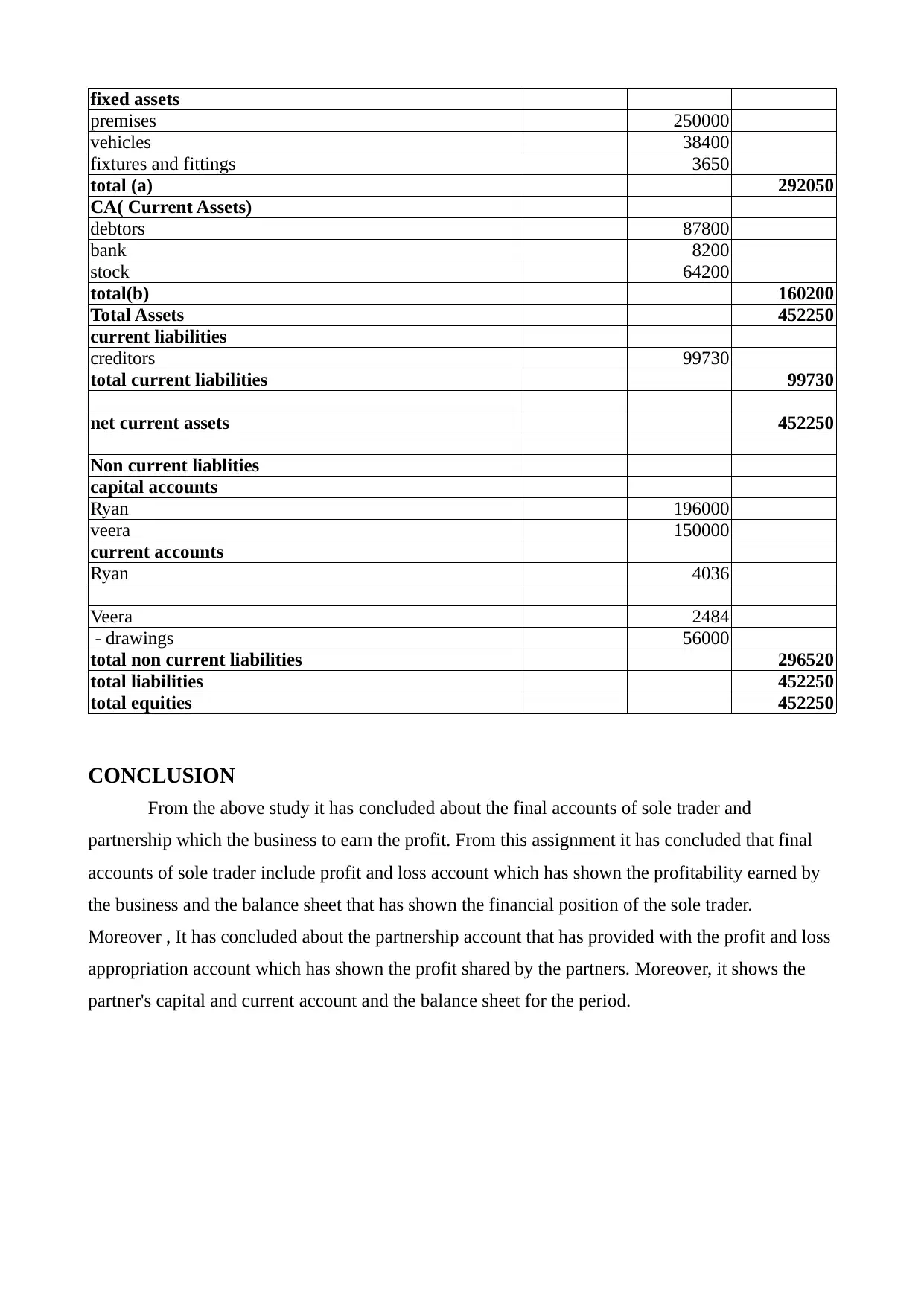
fixed assets
premises 250000
vehicles 38400
fixtures and fittings 3650
total (a) 292050
CA( Current Assets)
debtors 87800
bank 8200
stock 64200
total(b) 160200
Total Assets 452250
current liabilities
creditors 99730
total current liabilities 99730
net current assets 452250
Non current liablities
capital accounts
Ryan 196000
veera 150000
current accounts
Ryan 4036
Veera 2484
- drawings 56000
total non current liabilities 296520
total liabilities 452250
total equities 452250
CONCLUSION
From the above study it has concluded about the final accounts of sole trader and
partnership which the business to earn the profit. From this assignment it has concluded that final
accounts of sole trader include profit and loss account which has shown the profitability earned by
the business and the balance sheet that has shown the financial position of the sole trader.
Moreover , It has concluded about the partnership account that has provided with the profit and loss
appropriation account which has shown the profit shared by the partners. Moreover, it shows the
partner's capital and current account and the balance sheet for the period.
premises 250000
vehicles 38400
fixtures and fittings 3650
total (a) 292050
CA( Current Assets)
debtors 87800
bank 8200
stock 64200
total(b) 160200
Total Assets 452250
current liabilities
creditors 99730
total current liabilities 99730
net current assets 452250
Non current liablities
capital accounts
Ryan 196000
veera 150000
current accounts
Ryan 4036
Veera 2484
- drawings 56000
total non current liabilities 296520
total liabilities 452250
total equities 452250
CONCLUSION
From the above study it has concluded about the final accounts of sole trader and
partnership which the business to earn the profit. From this assignment it has concluded that final
accounts of sole trader include profit and loss account which has shown the profitability earned by
the business and the balance sheet that has shown the financial position of the sole trader.
Moreover , It has concluded about the partnership account that has provided with the profit and loss
appropriation account which has shown the profit shared by the partners. Moreover, it shows the
partner's capital and current account and the balance sheet for the period.
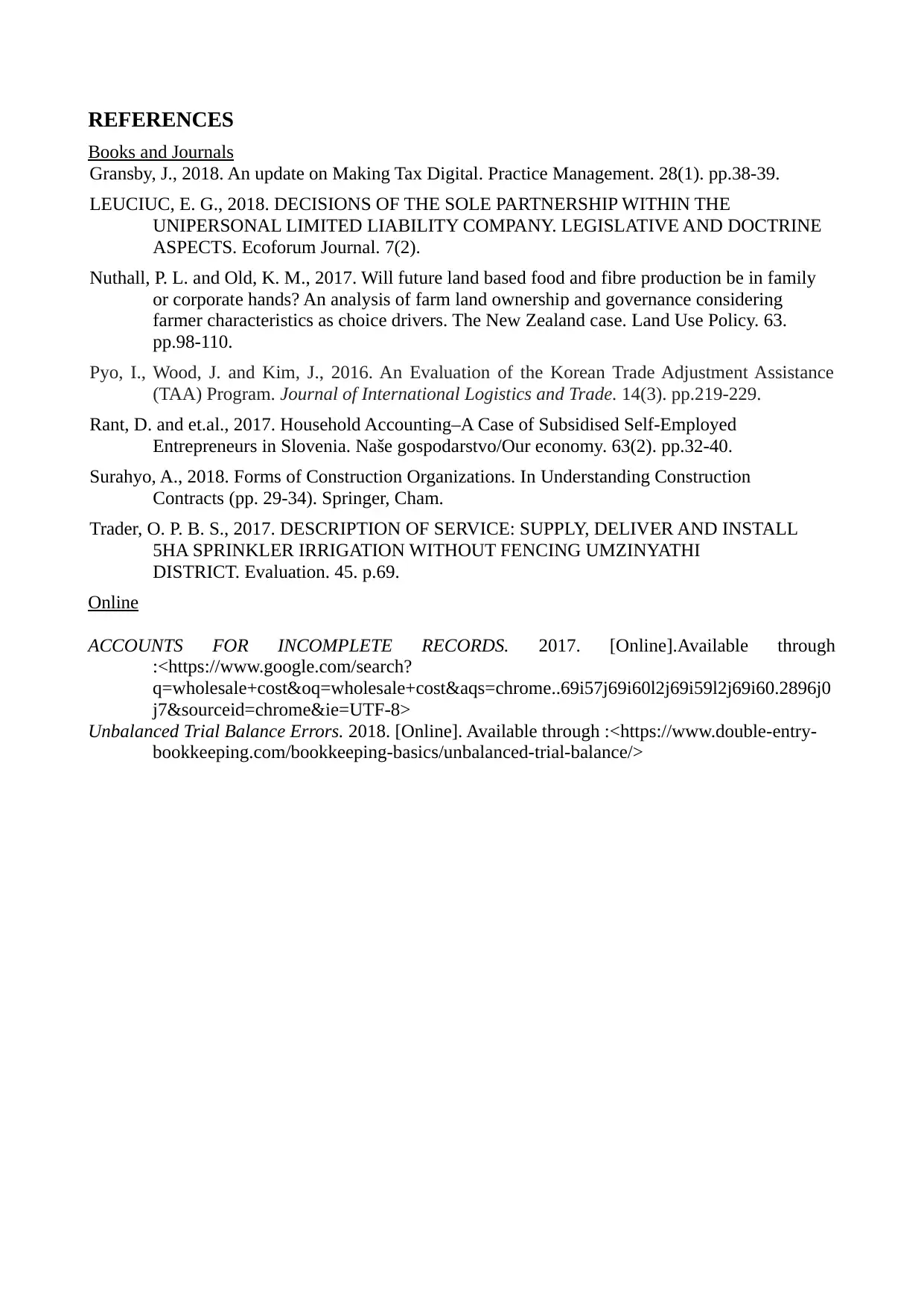
REFERENCES
Books and Journals
Gransby, J., 2018. An update on Making Tax Digital. Practice Management. 28(1). pp.38-39.
LEUCIUC, E. G., 2018. DECISIONS OF THE SOLE PARTNERSHIP WITHIN THE
UNIPERSONAL LIMITED LIABILITY COMPANY. LEGISLATIVE AND DOCTRINE
ASPECTS. Ecoforum Journal. 7(2).
Nuthall, P. L. and Old, K. M., 2017. Will future land based food and fibre production be in family
or corporate hands? An analysis of farm land ownership and governance considering
farmer characteristics as choice drivers. The New Zealand case. Land Use Policy. 63.
pp.98-110.
Pyo, I., Wood, J. and Kim, J., 2016. An Evaluation of the Korean Trade Adjustment Assistance
(TAA) Program. Journal of International Logistics and Trade. 14(3). pp.219-229.
Rant, D. and et.al., 2017. Household Accounting–A Case of Subsidised Self-Employed
Entrepreneurs in Slovenia. Naše gospodarstvo/Our economy. 63(2). pp.32-40.
Surahyo, A., 2018. Forms of Construction Organizations. In Understanding Construction
Contracts (pp. 29-34). Springer, Cham.
Trader, O. P. B. S., 2017. DESCRIPTION OF SERVICE: SUPPLY, DELIVER AND INSTALL
5HA SPRINKLER IRRIGATION WITHOUT FENCING UMZINYATHI
DISTRICT. Evaluation. 45. p.69.
Online
ACCOUNTS FOR INCOMPLETE RECORDS. 2017. [Online].Available through
:<https://www.google.com/search?
q=wholesale+cost&oq=wholesale+cost&aqs=chrome..69i57j69i60l2j69i59l2j69i60.2896j0
j7&sourceid=chrome&ie=UTF-8>
Unbalanced Trial Balance Errors. 2018. [Online]. Available through :<https://www.double-entry-
bookkeeping.com/bookkeeping-basics/unbalanced-trial-balance/>
Books and Journals
Gransby, J., 2018. An update on Making Tax Digital. Practice Management. 28(1). pp.38-39.
LEUCIUC, E. G., 2018. DECISIONS OF THE SOLE PARTNERSHIP WITHIN THE
UNIPERSONAL LIMITED LIABILITY COMPANY. LEGISLATIVE AND DOCTRINE
ASPECTS. Ecoforum Journal. 7(2).
Nuthall, P. L. and Old, K. M., 2017. Will future land based food and fibre production be in family
or corporate hands? An analysis of farm land ownership and governance considering
farmer characteristics as choice drivers. The New Zealand case. Land Use Policy. 63.
pp.98-110.
Pyo, I., Wood, J. and Kim, J., 2016. An Evaluation of the Korean Trade Adjustment Assistance
(TAA) Program. Journal of International Logistics and Trade. 14(3). pp.219-229.
Rant, D. and et.al., 2017. Household Accounting–A Case of Subsidised Self-Employed
Entrepreneurs in Slovenia. Naše gospodarstvo/Our economy. 63(2). pp.32-40.
Surahyo, A., 2018. Forms of Construction Organizations. In Understanding Construction
Contracts (pp. 29-34). Springer, Cham.
Trader, O. P. B. S., 2017. DESCRIPTION OF SERVICE: SUPPLY, DELIVER AND INSTALL
5HA SPRINKLER IRRIGATION WITHOUT FENCING UMZINYATHI
DISTRICT. Evaluation. 45. p.69.
Online
ACCOUNTS FOR INCOMPLETE RECORDS. 2017. [Online].Available through
:<https://www.google.com/search?
q=wholesale+cost&oq=wholesale+cost&aqs=chrome..69i57j69i60l2j69i59l2j69i60.2896j0
j7&sourceid=chrome&ie=UTF-8>
Unbalanced Trial Balance Errors. 2018. [Online]. Available through :<https://www.double-entry-
bookkeeping.com/bookkeeping-basics/unbalanced-trial-balance/>

1 out of 16
![[object Object]](/_next/static/media/star-bottom.7253800d.svg)





